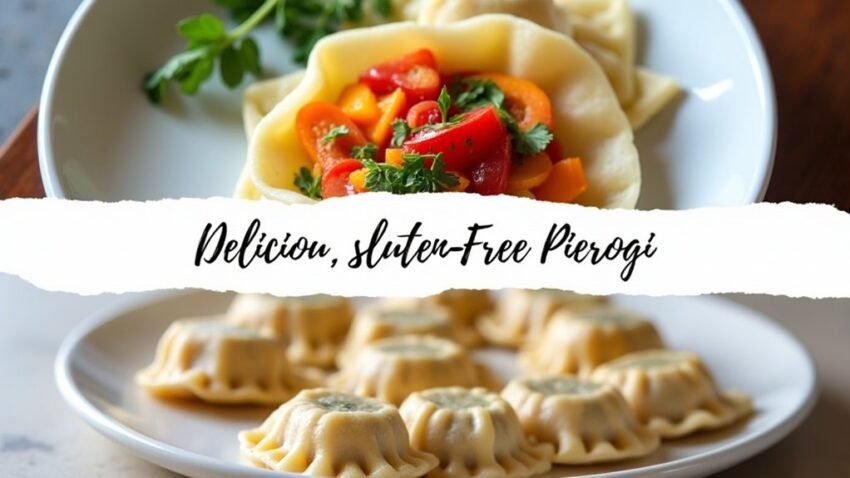Delicious Gluten-Free Pierogi

Delicious Gluten-Free Pierogi
If you’re looking to enjoy pierogi without gluten, you might be surprised at how satisfying and flavorful they can be. By using a thoughtful combination of gluten-free flours, you can create a dough that’s both pliable and robust, making it ideal for a range of delicious fillings. Imagine biting into a perfectly cooked pierogi, where the outer layer offers a soft yet slightly crispy texture, complementing the savory goodness within. But what’s the secret to achieving that perfect balance? There’s more to investigate about the history and variations that make gluten-free pierogi truly special.
Key Takeaways
- Use a blend of gluten-free flours like Cup4Cup or Bob’s Red Mill for the best dough texture.
- Traditional fillings such as potato and cheese can be enhanced with ingredients like onions or bacon.
- Prepare the dough by chilling it for 30 minutes to ensure easy rolling and shaping.
- Boil the pierogi until they float, then pan-fry for a crispy texture and delicious flavor.
- Customize fillings based on dietary preferences and serve with sauces like sour cream for added taste.
History
Tracing its origins back to ancient China, the concept of filled dumplings journeyed along the Silk Road to Europe, where it found a warm welcome among Slavic cultures. Slavs adapted the idea by filling dumplings with locally available ingredients, such as wild mushrooms and minced game.
Over time, this culinary tradition evolved in Poland, where pierogi began incorporating wheat and popular local fillings like potatoes and cheese. The journey of pierogi took a modern twist when they were adapted to be gluten-free, allowing those with dietary restrictions to enjoy traditional Polish flavors.
Historically, pierogi symbolize cultural exchange and tradition, reflecting societal changes. Once considered a luxury food, they became accessible to everyone, highlighting their role in daily life. As trade routes expanded, new ingredients like potatoes and cottage cheese entered the mix, enriching the pierogi experience.
Today, pierogi are known by various names across cultures, such as pirohy in Slovakia and varenyky in Ukraine. These variations demonstrate their widespread significance and adaptability.
Pierogi serve as a culinary bridge between cultures, blending different traditions into a beloved dish. Their evolution not only marks Poland’s history but also showcases the interconnectedness of global cuisines, making them a staple enjoyed by many around the world.
Recipe
Gluten-Free Pierogi Recipe
Gluten-free pierogi are a delicious and versatile dish that can be filled with a variety of ingredients, ranging from traditional potato and cheese to more creative fillings like sauerkraut or mushrooms. This recipe will guide you through making your own gluten-free dough and filling, creating a satisfying meal perfect for any occasion. The beauty of pierogi lies in their adaptability; you can customize the filling to suit your taste or dietary preferences. The dough is made using a blend of gluten-free flours, ensuring a delightful texture while remaining gluten-free. Once assembled and cooked, these pierogi can be enjoyed boiled or pan-fried for that perfect crispy finish. Gluten-free pierogi can be prepped in advance by assembling dumplings on a baking tray before freezing, making them ideal for meal prep and convenient eating.
Gather your ingredients, roll up your sleeves, and let’s get started on this delightful culinary adventure!
Ingredients:
– 3 cups gluten-free flour blend
– 4 ½ cups all-purpose gluten-free flour
– 3 cups gluten-free and dairy-free flour
– 2 cups (270 grams) gfJules All-Purpose Gluten-Free Flour
– 4 ⅓ cups Gluten-Free All-Purpose Flour
– 1-2 russet potatoes
– 1 small yellow onion
– 4 tablespoons unsalted butter (or vegan butter)
– 1 cup cheddar cheese (or vegan cheddar cheese)
– Water
– 1 large egg
– Salt
– Oil
Cooking Instructions:
To make the gluten-free pierogi, first prepare the dough by combining the gluten-free flour with a pinch of salt in a mixing bowl.
In a separate bowl, whisk together one large egg, water, and oil. Gradually add this wet mixture to the flour, mixing until a dough forms. Knead the dough gently for 1-2 minutes until smooth, then wrap it in plastic and let it chill in the refrigerator for about 30 minutes.
Meanwhile, prepare the filling by boiling the russet potatoes until tender, then mashing them with the butter, sautéed onions, and cheddar cheese until creamy.
Roll out the chilled dough on a lightly floured surface, cut out circles, fill them with the potato mixture, and fold the dough over to create half-moons. Seal the edges with water and a fork.
Boil the pierogi in salted water until they float, about 5 minutes, then pan-fry them in a skillet for a crispy exterior.
Extra Tips:
For the best texture, be sure to use a high-quality gluten-free flour blend that includes xanthan gum or another binding agent. This helps mimic the elasticity of traditional dough.
You can also experiment with different fillings based on seasonal vegetables or your favorite cheeses. If you plan to freeze the pierogi, do so after boiling but before pan-frying; simply place them on a baking sheet to freeze individually before transferring them to a freezer bag.
Reheat by boiling or pan-frying straight from the freezer for a quick and easy meal. Enjoy your homemade gluten-free pierogi!
Final Thoughts
With regard to enjoying gluten-free pierogi, you’ll find that they not only satisfy cravings but also provide endless possibilities for customization. These delightful dumplings can be tailored to your taste by varying the fillings and cooking methods. Here’s a summary of what you can expect:
-
Nutritional Information: Three gluten-free potato and cheddar cheese pierogi contain around 290 calories, with 36g carbs, 12g fat, and 8g protein.
-
Preparation Tips: Handle the dough carefully to prevent tearing. Opt for dry curd cottage cheese for the filling, and remember, you can freeze them for quick meals. Additionally, consider using gluten-free options to accommodate dietary needs.
-
Variations: Experiment with different gluten-free flours and fillings like potato, cheese, onions, or bacon. Cooking methods such as boiling followed by pan-frying can improve flavor and texture.
-
Product Availability: Brands like Joe’s Perogies and Conte’s Pasta offer a variety of options, including frozen pierogi that can be ordered online.
Ultimately, gluten-free pierogi aren’t just a delicious meal but also a versatile dish that accommodates dietary restrictions while providing a comforting culinary experience.
Enjoy the journey of creating and savoring these tasty treats.
FAQ
When you’re diving into the world of gluten-free pierogi, you might’ve a few questions about the best practices and tips for success. Here’s a quick FAQ to guide you.
What gluten-free flours work well?
-
Use gluten-free all-purpose flour blends like Cup4Cup or Bob’s Red Mill 1:1 Gluten-Free Baking Flour.
-
Specific blends such as gfJules All-Purpose Gluten-Free Flour yield good results.
-
A mix of sorghum flour, tapioca starch, potato starch, and sweet rice flour can also be effective.
How to assemble gluten-free pierogi?
-
Mix your dough ingredients and knead until smooth; let it rest.
-
Roll out the dough and cut circles using a biscuit cutter or glass.
-
Add a dollop of filling, fold over, and seal with water and a fork.
-
Boil until they float, then pan-fry for crispiness. Gluten free pierogi are versatile dumplings that can be filled with various ingredients to suit different tastes.
What if the dough is too dry or sticky?
-
Add water if dry, or more flour if sticky.
-
Knead gently to avoid crumbling.
How to store and serve?
-
Store in the refrigerator or freeze.
-
Serve with sauces like sour cream or apple sauce.
